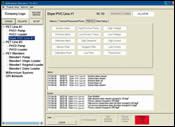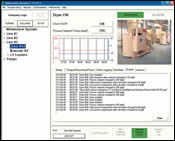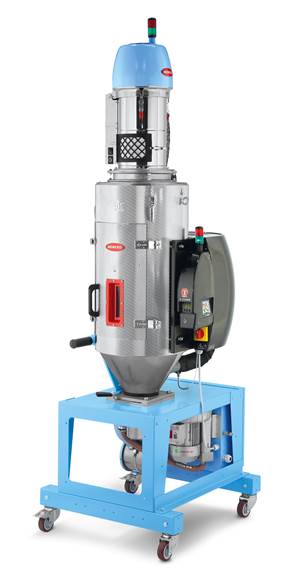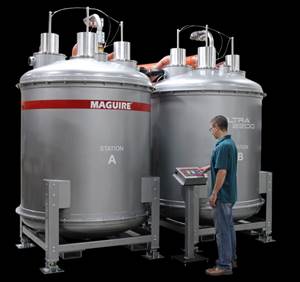To Catch Trouble Early, Put Your Dryers on the Net
In the past, troubleshooting your resin dryer was a fairly straightforward procedure.
In the past, troubleshooting your resin dryer was a fairly straightforward procedure. If there were no visible defects in the finished parts, then there was no need to touch the dryer. If something looked out of line, then checking the heaters with an amp meter or making sure the blowers were rotating and the filters weren’t blocked would solve 95% of all system problems. On the rare occasion that more investigation was re quired, a desiccant test or valve-leakage check would diagnose the problem. Since the dryers themselves were simple, repair was straightforward.
Today, resins and machinery have become more sophisticated (and expensive), making the cost of downtime for unscheduled maintenance and repair less tolerable. With production schedules taking precedence over maintenance, a device needing maintenance or repair is often ignored until complete failure is experienced. Alarms signaling dirty dryer filters or heater burnouts are often silenced or overridden, as long as the product still looks okay.
Today, most processors have instituted preventive maintenance programs for their molding ma chines, but if any attention is given to the auxiliary equipment, it is usually limited to checking the filters and returning the unit to operation as quickly as possible.
There is an imminent need for a more efficient way of tracking and controlling the behavior of process dryers. Available electronic sensing and communications hardware and software can assist in diagnostics and contribute to raising production time and lowering downtime.
Centralize data gathering
The most basic solution to assist in dryer diagnostics is a microprocessor-based control system. This type of control platform can interface with the plantwide control or enterprise computer system. It presents a central information-gathering and recording system that allows the plant manager to visualize dryer performance and address malfunctions. The information available to the control system depends on the connection of the dryer to the SPI communication port on the controls linking it to the host computer system.
A number of suppliers offer proprietary software packages, such as Wonderware, that permit dryer monitoring and can be configured by the user through the operator interface. This is an improvement over the older discrete controls, which lacked the ability to interface with a centralized data system.
Continuing efforts to improve control of drying systems have spawned internet- or intranet-based controls with the capability to provide necessary information to the proper individuals in real time, enabling them to decide when and how to make necessary repairs.
The arrival of computer systems in manufacturing plants has overloaded users with huge volumes of undigested process data. The actual value of that data is only apparent once it has been distilled into a usable form and made available to appropriate personnel for action. The new control and monitoring systems available today offer effective information management on the factory floor—troubleshooting your problems before they shoot you.
Let’s look at a few examples of how this can work:
Example A: trend spotting
PET bottle preform molding is a relatively critical process that requires proper resin drying to succeed. While observing the drying system operation on a computer screen, a maintenance technician at one preform plant noted the heating and cooling trends of the desiccant regeneration system. This enabled the technician to diagnose a leaking valve in the dehumidifier. Because the dewpoint, airflow, and temperature were all well within specifications, there was no need to interrupt the process. However, scheduling preventive maintenance action allowed the staff to have the necessary parts ordered and available to install during the allocated downtime.
Had the problem not been identified in this timely manner, it would have certainly shown up as a loss of dewpoint control at a later time and resulted in a significant interruption of production. The internet-ready control enabled the operator to acquire the data on machine performance and transmit that information directly via e-mail to the manufacturer of the dryer to obtain the correct replacement parts.
Example B: Who’s got mail
In one plant using central control and monitoring of materials handling, if a dryer presents a dewpoint alarm, the control system can be preconfigured to log the fault code, which will in turn generate an e-mail message to the service department of the dryer manufacturer requesting an evaluation of the machine and recommendations for repair. If parts are needed to make the repair, a quote is provided by the vendor’s parts department, listing everything that is needed for the repair.
Example C: A dangerous game
For assistance in diagnosing a host-computer system problem, remote terminal software (such as PC Anywhere) can connect by phone or internet to the problem system. Because the service technician utilizing the software can view remotely the necessary files at the user’s plant, the technician is able to evaluate and even replace corrupted programs or data files while connected over the internet.
This capability came in handy when an operator decided to play unauthorized computer games on the host computer and corrupted the data files being used. A set of files were recreated at the vendor’s office 2000 miles away and then reloaded into the plant system over the internet to rectify the problem. The plant system was back in operation in a few hours, avoiding the cost and delay of a service visit by the technician.
Related Content
Compact, Mobile Dryer Has Unique Conveying Capabilities
Mobile dryer includes closed-loop conveying to minimize the use of ambient air for resin movement.
Read MoreHigh-Output Dryer Requires Less Energy
Maguire’s ULTRA 2200 is designed to meet high throughput requirements with a max capacity of 2200 lb/hr.
Read MoreACS Adds Midwest Regional Sales Manager
Auxiliary equipment supplier names Mike Tuchalski to post.
Read MoreHow to Effectively Reduce Costs with Smart Auxiliaries Technology
As drying, blending and conveying technologies grow more sophisticated, they offer processors great opportunities to reduce cost through better energy efficiency, smaller equipment footprints, reduced scrap and quicker changeovers. Increased throughput and better utilization of primary processing equipment and manpower are the results.
Read MoreRead Next
People 4.0 – How to Get Buy-In from Your Staff for Industry 4.0 Systems
Implementing a production monitoring system as the foundation of a ‘smart factory’ is about integrating people with new technology as much as it is about integrating machines and computers. Here are tips from a company that has gone through the process.
Read MoreAdvanced Recycling: Beyond Pyrolysis
Consumer-product brand owners increasingly see advanced chemical recycling as a necessary complement to mechanical recycling if they are to meet ambitious goals for a circular economy in the next decade. Dozens of technology providers are developing new technologies to overcome the limitations of existing pyrolysis methods and to commercialize various alternative approaches to chemical recycling of plastics.
Read MoreLead the Conversation, Change the Conversation
Coverage of single-use plastics can be both misleading and demoralizing. Here are 10 tips for changing the perception of the plastics industry at your company and in your community.
Read More













